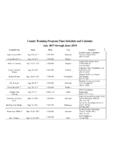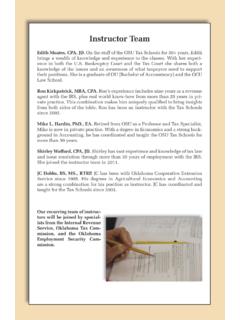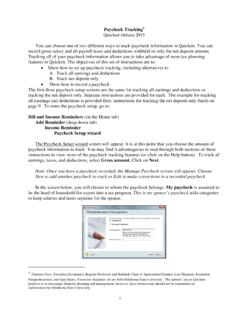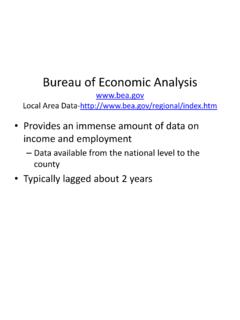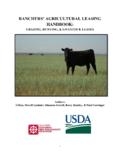Transcription of Oklahoma State University
1 In this issue: Leather Prices Soar 2 Oklahoma Pasture Rental Rates: Headed Up? 2 Pondering Farmer Age Statistics 5 Cow-Calf Producers Plan for 2015 6 Managing Cow-Calf Costs with OSU 7 The OSU-KSU Farm Bill Decision Tool. 7 New and Updated Publications 7 Farm Bill Date Reminder 8 Master Cattleman Quarterly Oklahoma State University Vol. 25 Dec. 2014 All signals point to go. Drought condi-tions that have hampered cow herd expansion in the recent past have been largely alleviated in this region, and cow calf returns are at his-toric highs. At the same time, the payments from the Livestock Forage Disaster Program have helped remedy some of the financial strain experienced in the less profitable, drought stricken, high feed stuff years.
2 Cow calf producers seem to be responding to the expansion call. As cow calf managers, the question of how to expand is more difficult than the ques-tion of should we expand. A quick survey of the markets show groups of yearling replace-ments about $1,700, bred heifers around $2,500, and aged cows selling higher than ever. Generally speaking, these prices are not out of line with the possible net returns from the current calf market, pasture conditions, and input costs. Unfortunately, evaluating the investment in a cow herd is a long term deci-sion that extends past the current markets.
3 Our other expansion option is to retain heifers that were raised on our own operation. This meth-od of expansion provides many advantages. Being able to retain females out of our own genetics that hopefully are a great match to our production system can pay long term divi-dends. There is also value in knowing how these heifers are developed nutritionally as research has shown time and time again that it impacts the long term productivity of the fe-males. Collectively, the more influence we have managing the heifers, the more certain we can be that it is done correctly.
4 Keep in mind that management decisions need to be evaluated again at these unprece-dented price levels. As a quick example, virtu-ally all producers would agree that we should select a calving ease bull to use on heifers. But, have we calculated what using that low birth weight bull costs an average size opera-tion? An average size cow calf operation con-sisting of 30 cows that keeps back 5 replace-ments every year to replace aging cows would only be able to justify having one bull around. If we purchased this bull with the intention to keep heifers then the birth weight EPD re-ceived quite a bit of selection pressure, and we sacrificed in other areas.
5 If our calving ease bull sacrifices 25 pounds of weaning weight on the calves from the 25 mature cows, then we have forfeited some significant revenue. Twenty-five pounds multiplied by 25 mature cows results in 625 pounds of weaning weight. At current prices, that would be well over $1,500 dollars. This lost revenue needs to be considered. This is just one example of a laundry list of factors to consider in the expansion equa-tion. The current market can push us to take another look at many decisions. Virtually eve-ry decision that we make on cow calf opera-tion right has significant implications as every pound of weaned calf lost or gained is worth more than it ever has been.
6 Iowa State Univer-sity has a great tool to help calculate the raise versus buy decision. It can be found at: Select the link titled Raising Heifers for Beef Cow Replacement. Every Decision Counts Scott Clawson, NE District Area Extension Ag Economics Specialist Page 2 Master Cattleman Quarterly Leather Prices Soar Livestock Marketing Information Center After tanning, a single steer hide can produce enough leather for 11 cowboy boots, 20 footballs or one sports car bucket seat. Hides are becoming more and more valuable as cattle supplies are tight, both domestically and world-wide, and demand for leather goods is increasing.
7 Hides are an important contributor to animal value and also con-stitute just over half of the non-meat or byproduct value. The USDA-AMS reports weekly beef byproduct pric-es, including hide values. Several wholesale hide prices are reported for steers, heifers, and cows including; heavy na-tive, native steer, Colorado branded, heavy Texas, and butt branded. The heavy native steer, Colorado branded steer, heavy Texas, and butt branded steer provide the most con-sistent price records. Since AMS began reporting those prices in 1995, heavy native steer hides have mostly stayed in the $60-$80 per hide range through 2008, with fairly consistent prices during a given year.
8 In 2009, the hide market took a significant downturn, along with the econo-my, with values dropping to a low of around $30 per hide. Mid 2010 saw a rebound in prices to normal levels, and since 2011 hide values have taken off. January of 2011 was the first time hide values eclipsed $80, since 2001. Heavy steer hide prices set a record the end of Septem-ber this year, at $ per piece. The most recent report recorded prices at $ per piece for the second week of November; year-over-year that is an 8% price increase. Compared to a $70 per hide average prior to 2009, whole-sale leather costs for luxury goods manufacturers have surged 60%.
9 As would be expected, industry sources are reporting high priced hides are causing some leather users to switch to less expensive lower grades of leather, canvas, and synthetic leather-like products. Some have even sug-gested changes in luxury women s boots toward shorter (ankle high) styles in part due to higher wholesale leather costs. For livestock producers, the cost of forage is a signifi-cant component of the total cost of production. A 2014 OSU spring calving cow-calf budget shows pasture is more than one-third of the annual operating costs when labor costs are included (the percent would be even higher if la-bor costs were ex-cluded).
10 Whether you rent or own pasture, it is helpful to be aware of both current market rates for pas-ture as well as trends over time. Here, we highlight some find-ings from the annual USDA/NASS June enumeration survey of land values and rental rates. A graph of pas-tureland values and rental rates shows the increase in both in recent decades (Figure 1). The land value scale is on the left and the solid line shows pastureland values averaged about $250 in 1970 and now are $1,500 per acre. The pas-ture cash rent scale is on the right. The dashed line shows average rental rates around $5 per acre in 1970, with rates now around $12 per acre.




